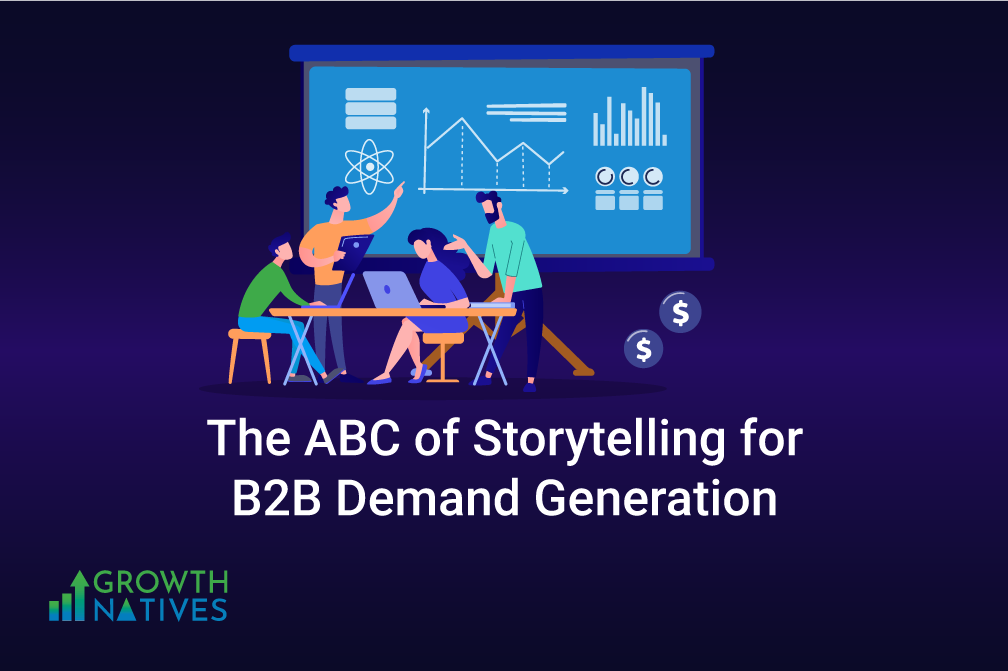The ABC of Storytelling for B2B Demand Generation

Table of Contents
The hard truth is that everyone in a B2B decision-making position is overwhelmed with emails, online ads, social posts assuring a 10% increase in productivity, better accuracy, improved analytics, and a funnel so full they’ll be forced to turn people away. Thus, inefficient B2B demand generation!
Yet, they don’t even click or care to give a response.
Ever wondered, why?
Well, it’s not a huge surprise. We are living in a culture so jam-packed with ads and promotions that South Park has already dedicated a full episode to what it feels like to be a human in the age of ads. They’ve become so irksome that every day, we learn new ways to ignore them.
But it doesn’t mean we as demand generators should give up!
Perhaps we need to see B2B demand generation beyond the “percentage increase” promises and infographics showing “disruptive” models.
It’s all about superb storytelling that will bring you visitors—stories that can sell your brand promise, coupled up with data and humanity into a neat, irresistible package.
Key to Storytelling in B2B Demand Generation

Before creating content or mapping a user flow, know what story you’re telling, and how different components of your story will fit together. It includes your customer story, industry story, and your brand story.
Think of it like a mathematical problem:
Successful brand story = customer story + industry story
When all three components work in synergy, you ensure your story hits the sweet spot with your prospects. But if it doesn’t, you will create continuous opportunities for your potential customers to drop out of your funnel.
Decoding Your Customer’s Story
Remember, your customer is the single most important piece of this story. Consider them as your hero, your main frame of reference, and—your paycheck.
So, don’t waste any time and gather as much as you can about your customers.
Start by revisiting your customer personas and verify them with your analytics platform to make sure you have the exact segments to build your story.
Once you gain a sufficient understanding of your personas, choose a few from your personal network, and do a little research on social networks to get a better sense of where they come from and where they’re going.
What’s important is that this should be fast, so that you’re able to fill in the gaps that personas can’t account for, and give you the sense of what’s really important for your target audience.
Understanding Your Industry
Most likely you’re well aware of the ideal industry for your product or service, but it’s a good idea to brush up your knowledge on the key challenges your potential customers are facing right now.
The best way to do so is to break into the most relevant blogs for an industry. You can start by Googling terms like “top [industry] blogs 2021” to get a list of blogs that you can use.
To go a step further, you can also check out blog aggregators like Feedly, Panda, and Pocket to piece your understanding together. Build persona-specific RSS feeds for whatever relevant you find by adding blogs you think are most relevant to a persona.
This will help you develop a good understanding of which stories are important to their specific industries, and how you can present your product as a lifesaver.
Killing It With Your Brand
It may seem obvious, since you already know your product inside out.
But don’t forget, correctly understanding your brand, in order to let your customer totally inform your product story is a different ball game.
Take this in small steps:
1. Consider your customer takeaways to analyze “who” and “how” of the story
Understand your customer and look for words to use, the kinds of stories that are best received, and the idea of how personal or impersonal you should be.
Once you analyze this, you’ll know how to approach by putting the buyer in the spotlight. Every good story makes the buyer a “hero”, and you must know what heroism means to your customers.
2. Think about industry takeaways
All great stories have conflicts, and in the business world, all conflicts are problems that need to be solved.
Use accurate “customer language” to develop a story on a business conflict worth solving—both economically and ideologically.
3. Let your product be the problem solver
You have created a great plot by fine-tuning your story to the persona and industry you’re selling to. The next step is to approach the problem, the way your customers want to.
Remember, you’ve built this story for them, not for your product. Consider your product just as a tool to solve the problem.
When you’re selling them the reality of being a better accountant, leader, or marketer, the tool itself is just a vehicle that ticks all the right boxes.
Once you figure out all of this, you’ll clearly understand your story: the plot, the hero, and the weapon (your product).
And with the right language and timing, you can build an impactful story-driven demand generation flow that creates a better customer experience and drive revenue growth.




